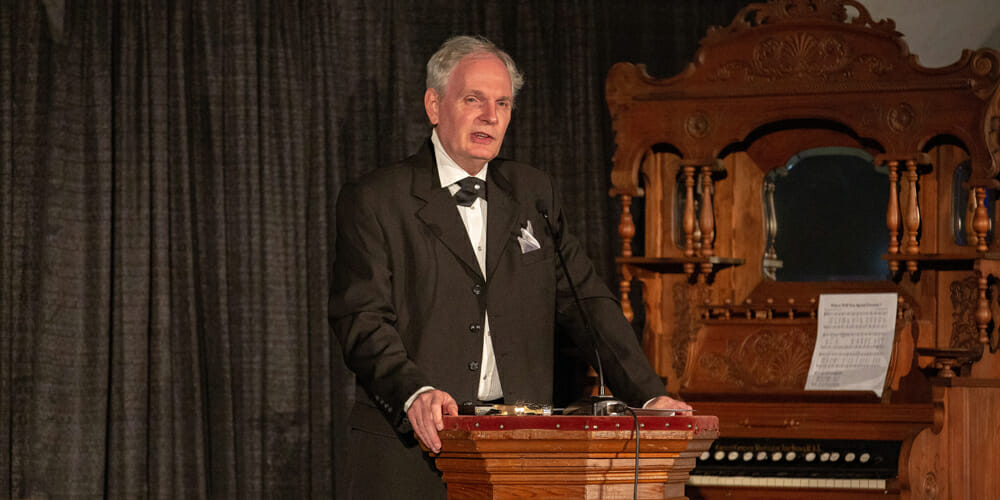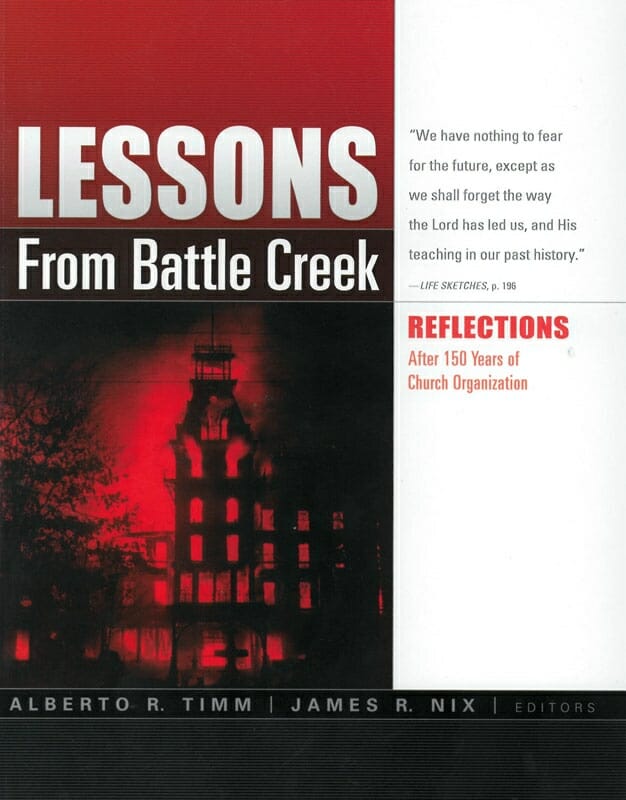What lessons can we learn from the most iconic place in Seventh-day Adventist history?

As has been the practice for the last few years, the 2018 Annual Council of the Seventh-day Adventist Church also opened with a Leadership Education and Development Conference (LEAD). Church leaders and scholars presented on topics which this year focused on the early history of the Seventh-day Adventist Church. It seems fit, as the General Conference Executive Committee members attending Annual Council have convened in Battle Creek, Michigan, United States, a place closely connected to the early history of the denomination. Below is an October 12 presentation by White Estate associate director Alberto Timm, which discussed some lessons Seventh-day Adventists can learn from the ups and downs of the Adventist experience in Battle Creek. Timm’s presentation served as an introduction to the presentation of the book Lessons from Battle Creek (Review and Herald, 2018), which he co-edited with White Estate director James R. Nix. Elements of the oral presentation have been retained. —Adventist Review Editors
What comes to your mind when you hear the name “Battle Creek”? From a sociopolitical perspective, the name “battle” could suggest that an important war occurred somewhere around here. But as pointed out by James Nix, it was just a fight between four men — two United States government contract surveyors and two Potawatomi Indians. From a business perspective, the name “Battle Creek” is associated with Kellogg’s Company, the powerful American multinational food-manufacturing company headquartered in this city.
From an Adventist perspective, however, no other city in the world has been the stage for so many significant events in the development and consolidation of the Seventh-day Adventist Church as Battle Creek. Here you can allow your imagination to see Joseph Bates knocking at the door of David Hewitt — “the most honest man in town” — and sharing with him and his family the Adventist message. You can view Ellen G. White writing out her 1858 Great Controversy vision. Here you can watch our denominational forefathers choosing the name “Seventh-day Adventist”; organizing the General Conference; opening first the Western Health Reform Institute (later renamed to Battle Creek Sanitarium) and then the Battle Creek College; and reorganizing our Church structure at the1901 General Conference Session. You can also observe the political and bellicose spirit that culminated with the strange “fires” identified by Ellen White as God’s punitive judgments.

In 1 Corinthians 10 the apostle Paul reflects on the 40 years of pilgrimage of the Israelites in the wilderness (vv. 1-10), and then adds in verses 11-13 (NIV), “These things happened to them as examples and were written down as warnings for us, on whom the culmination of the ages has come. So, if you think you are standing firm, be careful that you don’t fall! No temptation has overtaken you except what is common to mankind. And God is faithful; he will not let you be tempted beyond what you can bear. But when you are tempted, he will also provide a way out so that you can endure it.”
Paul encouraged his readers to familiarize themselves with the history of God’s people and to learn from it. George Santayana (1863-1952) warned, “Those who cannot remember the past are condemned to repeat it.” This being the case, we could ask ourselves a few questions: What brought us here to Battle Creek? Are we really interested in being inspired and actually learn from our past?
Let me highlight a few lessons I believe are very significant for all of us.
1. Our history, permeated by struggles and tensions, can only be understood within the framework of the great cosmic-historical controversy between good and evil. This framework can help us to unveil some of the most complex chapters of our history and should help us to realize that prayer and spirituality, as important as they are, do not imply infallibility. The fact that the Lord spoke through Balaam (Num. 22-24) and that Satan influenced Peter to deny Christ’s prediction of the cross (Matt. 16:21-23) should remind us that we are all fallible human beings whose strength is only in the Lord.
2. Our authority—whether spiritual, academic, or administrative—is directly proportional to our loyalty to God’s Word. The Holy Spirit has granted to the church different gifts, talents, and offices (1 Cor. 12; Eph. 4:11-16), and we should respect our leaders (1 Thess. 5:12-14; Heb. 13:17). But our authority is not inherent in us; it derives from God and His infallible Word. According to Alister E. McGrath, “the reformers argued that authority within the church does not derive from the status of the office bearer, but from the Word of God which the office bearer serves.” This means that my decisions and our decisions “are authoritative and binding to the extent that they are faithful to Scripture.”
3. In the inspired writings we find laws/norm, principles, and counsels which should be allowed to remain as such. Crucial for all interpretation of the inspired writings—the Scriptures and the writings of Ellen White—is to identify and distinguish between (1) laws/norms, (2) principles, and (3) counsels. Liberals tend to lower laws/norms to the level of mere counsels. Fanatics tend to elevate counsels to the level of laws/norms. So, we should allow each of those three categories to remain as such, without moving them into a category to which they do not belong to. This is not an easy task, but it can help us to avoid many doctrinal, theological, and administrative tensions.
4. Many crises within the church are aggravated by our human tendency to overstate our causes. “Bending the stick” is a woodworking technique where a piece of wood is bent too far in one direction so that it will end up straight. It can work well with pieces of wood and even trees, but not necessarily with matters truth and principles. As well stated by William Struck Jr. and E. B. White in their classical book, The Elements of Style, “When you overstate, readers will be instantly on guard, and everything that has preceded your overstatement as well as everything that follows it will be suspect in their minds because they have lost confidence in your judgment or your poise.” And it becomes even worse when people end up labeling each other.
5. We should be mature enough to deal with extremely controversial issues without confusing the issues (which need to be addressed) with people (who should be loved). In our competitive world, our human tendency is to undermine the reputation of people who do not see things from my own perspective. Tensions about issues can easily become wars of personalities, with winners and losers! Remember that even the disciples of Jesus discussed who was the greatest among them (Mark 9:33-34). Shortly after, two of the disciples approach Him with the political request, “Grant us that we may sit, one on Your right hand and the other on Your left, in Your glory” (Mark 10:37, NKJV). But Jesus answered, “You know that those who are considered rulers over the Gentiles lord it over them, and their great ones exercise authority over them. Yet it shall not be so among you (Mark 10:42, 43, NKJV).
6. We should never lose sight of God’s leading. God has entrusted us different responsibilities, and we are considered accountable for it. But, unfortunately, throughout our history, we have had too many people who behaved as self-proclaimed “saviors” of the Church. Never forget that we have only one Savior and Lord who is Jesus Christ, and He is carrying for His church! In 1892, Ellen White wrote, “There is no need to doubt, to be fearful that the work will not succeed. God is at the head of the work, and He will set everything in order. If matters need adjusting at the head of the work, God will attend to that, and work to right every wrong. Let us have faith that God is going to carry the noble ship which bears the people of God safely into port.” Some ten years later she penned to those working among the former slaves in the Southern Field, “Difficulties will arise that will try your faith and patience. Face them bravely. Look on the bright side. If the work is hindered, be sure that it is not your fault, and then go forward, rejoicing in the Lord.”
Is this not a good counsel for us as well? The six points I just highlighted are of a more general nature. Couldn’t I have been a little bit more precise in my approach, even providing some examples to illustrate my points? Yes, I could. But I purposely decided to address the topic from a more general perspective. Why? Because this is not the end of my presentation. Today we are dedicating the book Lessons from Battle Creek (Review and Herald, 2018), released just now for this conference! It contains the revised and updated versions of all the papers and speeches presented during the 2013 General Conference Spring Meetings here in Battle Creek.
Before we proceed with the dedication of this very insightful book, I want to read the following statement by Ellen G. White, “The records of sacred history are written, not merely that we may read and wonder, but that the same faith which wrought in God’s servants of old may work in us. In no less marked manner will the Lord work now, wherever there are hearts of faith to be channels of His power.”








